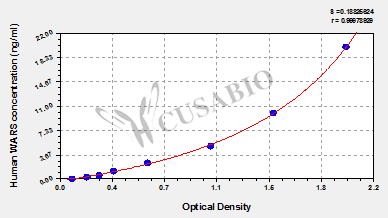| Code | CSB-E11789h |
| Size | 96T,5×96T,10×96T |
| Price | Request a Quote or Start an on-line Chat |
| Trial Size |
24T ELISA Kit Trial Size (Only USD$150/ kit) * The sample kit cost can be deducted from your subsequent orders of 96T full size kits of the same analyte at 1/5 per kit, until depleted in 6 months. Apply now |
| Intra-assay Precision (Precision within an assay): CV%<8% | ||||||
| Three samples of known concentration were tested twenty times on one plate to assess. | ||||||
| Inter-assay Precision (Precision between assays): CV%<10% | ||||||
| Three samples of known concentration were tested in twenty assays to assess. | ||||||
| To assess the linearity of the assay, samples were spiked with high concentrations of human WARS in various matrices and diluted with the Sample Diluent to produce samples with values within the dynamic range of the assay. | ||||||
| Sample | Serum(n=4) | |||||
| 1:1 | Average % | 91 | ||||
| Range % | 88-95 | |||||
| 1:2 | Average % | 87 | ||||
| Range % | 81-93 | |||||
| 1:4 | Average % | 97 | ||||
| Range % | 93-101 | |||||
| 1:8 | Average % | 100 | ||||
| Range % | 94-106 | |||||
| The recovery of human WARS spiked to levels throughout the range of the assay in various matrices was evaluated. Samples were diluted prior to assay as directed in the Sample Preparation section. | ||||||
| Sample Type | Average % Recovery | Range | ||||
| Serum (n=5) | 89 | 84-95 | ||||
| EDTA plasma (n=4) | 93 | 88-99 | ||||
| These standard curves are provided for demonstration only. A standard curve should be generated for each set of samples assayed. | |||||||||||||||||||||||||||||||||||||||||||||||||||||||||||||||

|
|||||||||||||||||||||||||||||||||||||||||||||||||||||||||||||||
The product CSB-E11789h is a sandwich ELISA kit developed to measure levels of human tryptophanyl-tRNA synthetase (WARS) in serum, plasma, cell lysates, or tissue homogenates. The enzyme-substrate chromogenic reaction is also used to amplify the signal and quantify the levels of the analyte through the intensity of the colored product. The color intensity positively correlates with the amount of WARS bound in the initial step.
WARS is an essential enzyme because it catalyzes the ligation of tryptophan (Trp) to its cognate tRNAtrp during translation via aminoacylation. It is localized not only to the nucleus but also to the extracellular space, playing an important role in innate immunity, angiogenesis, and IFN-γ signaling. WARS expression varies significantly in different tissues and pathological states, implying that it plays unique roles in physiological homeostasis and immune defense. It is also involved in the pathogenesis of multiple diseases, including sepsis, cancer, and autoimmune and brain diseases.
There are currently no reviews for this product.